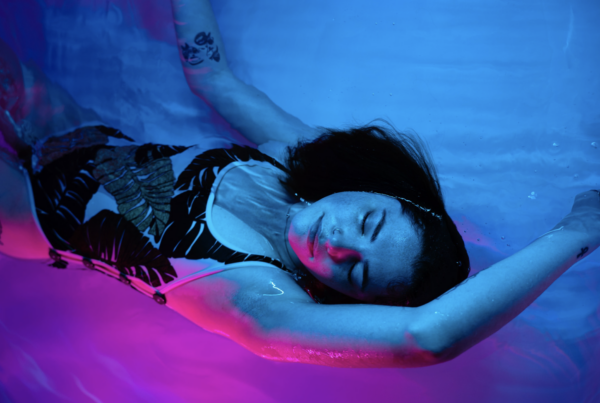There are many different terms for ‘sensory deprivation tank’ – whether you know what we do as float therapy, sensory deprivation tank therapy, or maybe you’ve heard of a ‘float tank’, ‘isolation tank’, or ‘sensory deprivation tank’ but don’t know what it actually is… We answer the most common queries here.
What is a sensory deprivation tank?
With a rich and varied history, floating has seen some interesting examples of environments created to offer sensory isolation. These days, it’s generally considered in the industry that a float pod offers the ultimate in floatation therapy.
The best are beautifully and ergonomically designed, look futuristic, but most importantly allow for the closest control of their climate. A pool or float room can’t rival a pod in this regard, as the latter enables precise adjustments in temperature of both the float solution and air, lighting, and audio, in a way that is almost impossible in an open room.
There are a few places available that simply have pools with Epsom salt, allowing multiple customers at once. Though like the Dead Sea, this might have some health benefits, it is not true float therapy and the effects anecdotally are far less profound than an advanced modern float tank or pod.
A proper float session reduces sensory input to the extent that an individual will usually experience sensory enhancement, in addition to dramatic reductions in stress, anxiety, or even physical pain.
The original float tank as created by neuroscientist John C. Lily looked like something you might see in an H. R. Giger (think Alien) artwork, where people would be entirely submerged with breathing apparatus attached.
Thankfully, the state-of-the-art Orbit floatation tank we use is much more user-friendly!
What is a sensory deprivation tank like?
Though the concept might seem a little surreal to those yet to try it, floatation therapy is one of the most calming experiences imaginable, and unlike anything else.
Upon arriving at our float centre, you’ll be given a tour including around your dedicated private float room, with every aspect thought out to create the ultimate float experience.
The pod itself is large enough for people up to 7’6″ tall, with an internal space around 30% larger than any other pod in London.
Unlike any other float spa in London, your pod will be empty as you arrive, and will gradually fill with a solution of water saturated with Epsom salt, freshly filtered, heated precisely to body temperature.
Once showered, you walk into the pod, close the door (it doesn’t lock, and you’re in control at all times), and once you lay back you’ll be suspended at the top of the water.
For sensory deprivation therapy, there is so much Epsom salt or magnesium sulfate in the solution, that your body is perfectly supported by it.
As the air temperature reaches close to the water temperature, it can be hard to feel where the water ends. Indeed, you shouldn’t really be aware of temperature as it’s neither hot nor cold compared with body temperature.
After five minutes of music accompanied by a sunset, light and sound will fade, and you’ll have a full 50 minutes of effortlessly floating in space.
It can take a few minutes to get used to the environment, though most people can reach something called theta state in ~40 minutes, a state of deep relaxation where your brainwave activity physically slows to theta waves.
Theta state is fairly common as you wake up from a deep sleep, and is thought to be a deep healing state, which offers enhanced creativity, problem-solving, and lets your nervous system recover from stresses it has been facing.
Some people expect to be able to totally clear their mind in a flotation tank, though as Theta state often increases cognitive function, it’s pretty common to experience mind-racing but with far greater clarity than you might be used to.
If your mind is racing, it still means that the float therapy is working, your body is in healing mode, and you’ll still emerge feeling invigorated, happier, and with less stress.
Are sensory deprivation tanks safe?
Float therapy is very safe for almost everyone.
The water is only 10 inches deep so you can reach the floor anytime you need to. The lighting and pod door is super simple to use, and always in your control.
Each flotation tank of ours contains a handy alert button for anyone who would like assistance.
As modern times have seen a far greater level of concern around viruses, you can rest assured that floating is one of the safest environments from the novel coronavirus.
Sars-COV-2 is not waterborne, but if it were, it would still be dealt with comfortably by our advanced filtration and hygiene processes:
Our solution contains safe levels of hydrogen peroxide, a non-toxic compound that is the active ingredient in many CDC-recommended disinfectants to destroy coronavirus.
It also has over 525KG of Epsom salt, a natural disinfectant that is thought to be effective against coronaviruses.
Our pods empty between each session, the only way to guarantee 100% filtration between each use.
100% of the solution goes through both a 1-micron filter, plus a powerful UVC filter which ensures any viruses that get past the peroxide or salt are killed.
We also disinfect all surfaces with non-toxic disinfectants, between each float session.
So, we’re confident that floating with us is totally safe.
Are sensory deprivation tanks claustrophobic?
Being in a floatation pod is usually the opposite of claustrophobic! As you are effortlessly suspended, it’s common to become less aware of surrounding physical boundaries, leading to a sensation of space.
Also, the effects of flotation therapy in reducing anxiety disorder, muscle tension, and blood pressure, usually combine well to reduce any feelings of phobia.
The relaxation offered has been shown to be very effective at treating anxiety, so you could experience a reduction in phobias after your session, too.
Is sensory deprivation safe for pregnancy?
In simple terms, float therapy simply creates an environment for your body to be relieved of external pressures or stimuli.
Pregnant women often report some of the most profound benefits from floating.
The feeling of weightlessness can take the pressure off. Increased beta-endorphin secretion (the body’s natural pain killer) can offer pain relief – a natural relief for chronic pain that is often felt towards the lower back.
As the water temperature is set precisely to body temperature, it is perfectly comfortable, without the danger of overheating that a hot bath at home might have.
Interestingly, the restriction of external stimuli can make a person more aware of what is happening within their body. It’s normal to hear your own heartbeat.
This environment has been reported to allow for a greater sense of connectedness between mother and unborn child.
Though there have never been any risks associated between floating and pregnancy, please do check with your GP before booking with us, to make sure they’re happy based on your personal situation (we aren’t able to offer medical advice).
Is sensory deprivation worth it?
Of course, we’d say 100% yes, but don’t take our word for it. We’ve got 300+ 5* reviews online, with a perfect 5* rating on TripAdvisor.
Though we’d like to think our attention to detail, customer service, and the overall environment we’ve created has influenced us becoming the highest-rated UK float centre, it’s largely because float therapy is amazing.
9/10 people who float with us love the experience, some experienced floaters have told us they think Float Hub is the best place in the world to do it, though it’s also rare to find a centre that isn’t at least 4* rated online.
Our memberships also offer incredible value for regular floating, and with no tie-ins offer the best way to try it out.
Why not book with us this week, and see what it’s all about?





